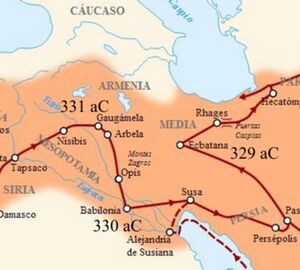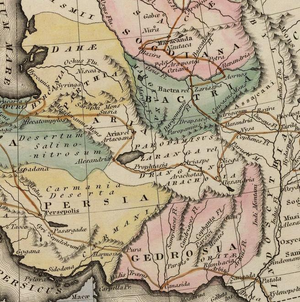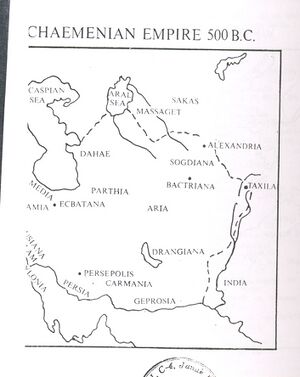Persepolis
| Author:Laxman Burdak, IFS (R) |



Persepolis (पर्सीपोलिस) was the ceremonial capital of the Achaemenid Empire (ca. 550–330 BC).
Location
Persepolis is situated 70 km northeast of the modern city of Shiraz in the Fars Province of modern Iran.
Variants of name
- Istakhr[1]
- Pārśapura (पार्शपुर)
- Pérsēs pólis
Origin of the name
The English word Persepolis is derived from the Greek Πέρσης πόλις Pérsēs pólis, meaning "Persian city". In Old-Persian it was called Pārśapura[2].
Jat clans
- Palsania (पलसानिया) Jat clan is believed by some authors to have originated from Persipolis (पर्सीपोलिस), the capital of Persian Empire of Iran. [3]
Jat Gotras Namesake
History
Archaeological evidence shows that the earliest remains of Persepolis date from around 515 BC. André Godard, the French archaeologist who excavated Persepolis in the early 1930s, believed that it was Cyrus the Great (Kūrosh) who chose the site of Persepolis, but that it was Darius I (Daryush) who built the terrace and the great palaces.
Mention by Pliny
Pliny[5] mentions ....It is requisite in this place to trace the localities of the Medi also, and to describe in succession the features of the country as far as the Persian Sea, in order that the account which follows may be the better understood. Media8 lies crosswise to the west, and so presenting itself obliquely to Parthia, closes the entrance of both kingdoms9 into which it is divided. It has, then, on the east, the Caspii and the Parthi; on the south, Sittacene, Susiane, and Persis; on the west, Adsiabene; and on the north, Armenia. The Persæ have always inhabited the shores of the Red Sea, for which reason it has received the name of the Persian Gulf. This maritime region of Persis has the name of Ciribo10; on the side on which it runs up to that of the Medi, there is a place known by the name of Climax Megale,11 where the mountains are ascended by a steep flight of stairs, and so afford a narrow passage which leads to Persepolis12, the former capital of the kingdom, destroyed by Alexander. It has also, at its extreme frontier, Laodicea13, founded by Antiochus.
8 Media occupied the extreme west of the great table-land of the modern Iran. It corresponded very nearly to the modern province of Irak-Ajemi.
9 The Upper and the Lower, as already mentioned.
10 Hardouin suggests that this should be Syrtibolos. His reasons for so thinking will be found alluded to in a note to c. 31. See p. 80, Note 98.
11 Or the "Great Ladder." The Baron de Bode states, in his Travels in Luristan and Arabistan, that he discovered the remains of a gigantic causeway, in which he had no difficulty in recognizing one of the most ancient and most mysterious monuments of the East. This causeway, which at the present day bears the name of Jaddehi-Atabeg, or the "road of the Atabegs," was looked upon by several historians as one of the wonders of the world, who gave it the name of the Climax Megale or "Great Ladder." At the time even of Alexander the Great the name of its constructor was unknown.
12 Which was rebuilt after it was burnt by Alexander, and in the middle ages had the name of Istakhar; it is now called Takhti Jemsheed, the throne of Jemsheed, or Chil-Minar, the Forty Pillars. Its foundation is sometimes ascribed to Cyrus the Great, but more generally to his son, Cambyses. The ruins of this place are very extensive.
13 Its site is unknown; but Dupinet translates it the "city of Lor."
Jat connections
Bhim Singh Dahiya[6] writes that About Spooner's idea regarding Lord Buddha, we are not sure but we heartily agree with him when he says that Persepolis was the "ancestral home", of the Mauryas. [7]They were from the ruling families-the Zantoi of Manda empire.
Bhim Singh Dahiya[8] writes:
109. Mardha/Mirdha - They are the same as the Mardi of Herodotus and Amardi of Strabo. The word Mardi means 'Heroes'. Alexander defeated them in 330 B.C. between Persepolis and the Persian Gulf. [9]
Bhim Singh Dahiya[10] writes:
The phrase, "Aryanām Dahyunām" of the Avesta, and the Persepolis inscription of Xerxas mention the Dahae people of Trans-caspiana. R.G. Kent says that Dahistan was the country of the Dahae.[11] The story of prince Hibil Ziwal, (originally a gāthā of the Mandas) given in the Syriac Acts of Judas Thomas, has been recapitulated by E.S. Drower.[12] The name of Hibil Ziwa's father, is given as Manda Dhiia. Here is perhaps the first mention of Dahia/Dahiya, and Manda is also a clan name of the Jats.
External links
References
- ↑ Sir H. M. Elliot: The History of India, as Told by Its Own Historians/IV. Al Istakhrí,p.26
- ↑ The Greeks and the Mauryas, pp. 17,40,185
- ↑ Mahendra Singh Arya et al.: Adhunik Jat Itihas, p. 263
- ↑ Mahendra Singh Arya et al.: Adhunik Jat Itihas, p. 263
- ↑ Natural History by Pliny Book VI/Chapter 29
- ↑ Jats the Ancient Rulers (A clan study)/Porus and the Mauryas,p.157
- ↑ Spooner, op. cit., p. 409.
- ↑ Jats the Ancient Rulers (A clan study)/Jat Clan in India,p.287
- ↑ Rawlinson, op. cit., vol. I, p. 338.
- ↑ Jats the Ancient Rulers (A clan study)/Jat Clan in India,p.251
- ↑ Languages, Vol. XII, p. 298.
- ↑ JRAS, 1954, p. 153.
Back to Jat Places in Iran

